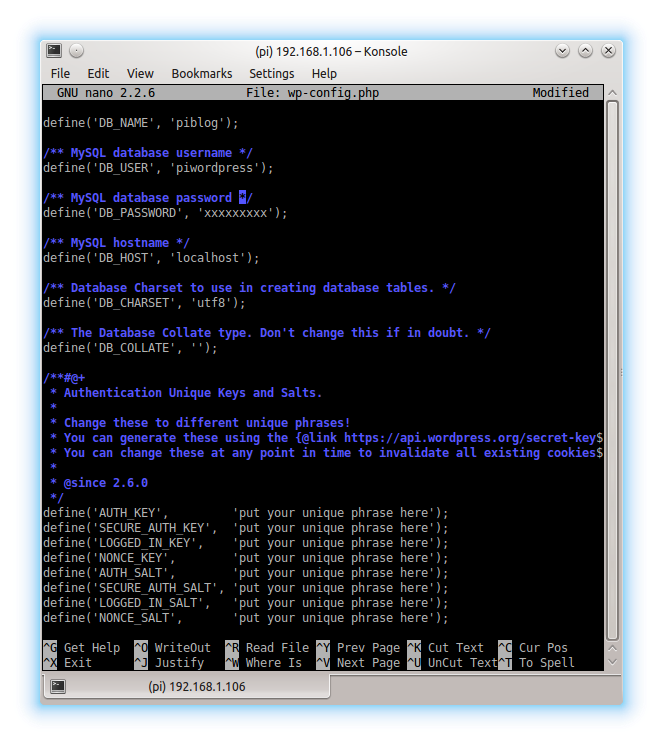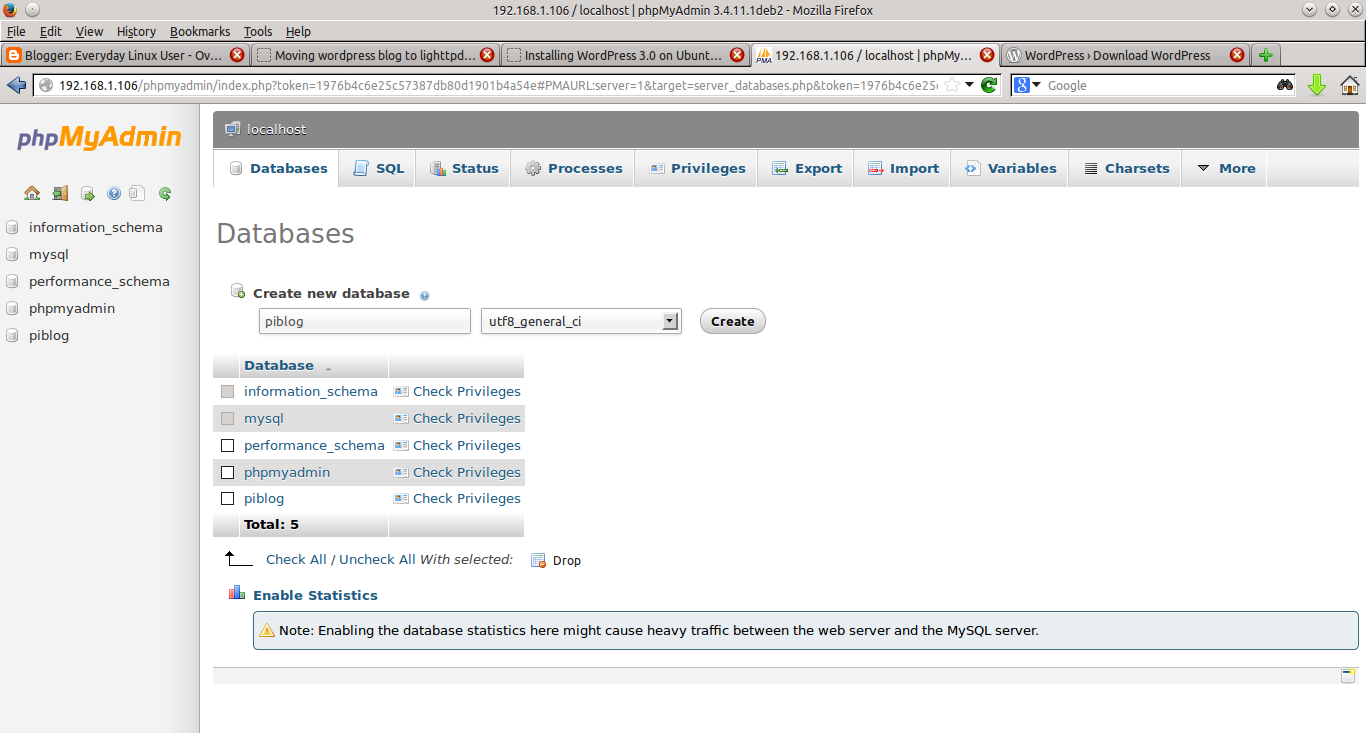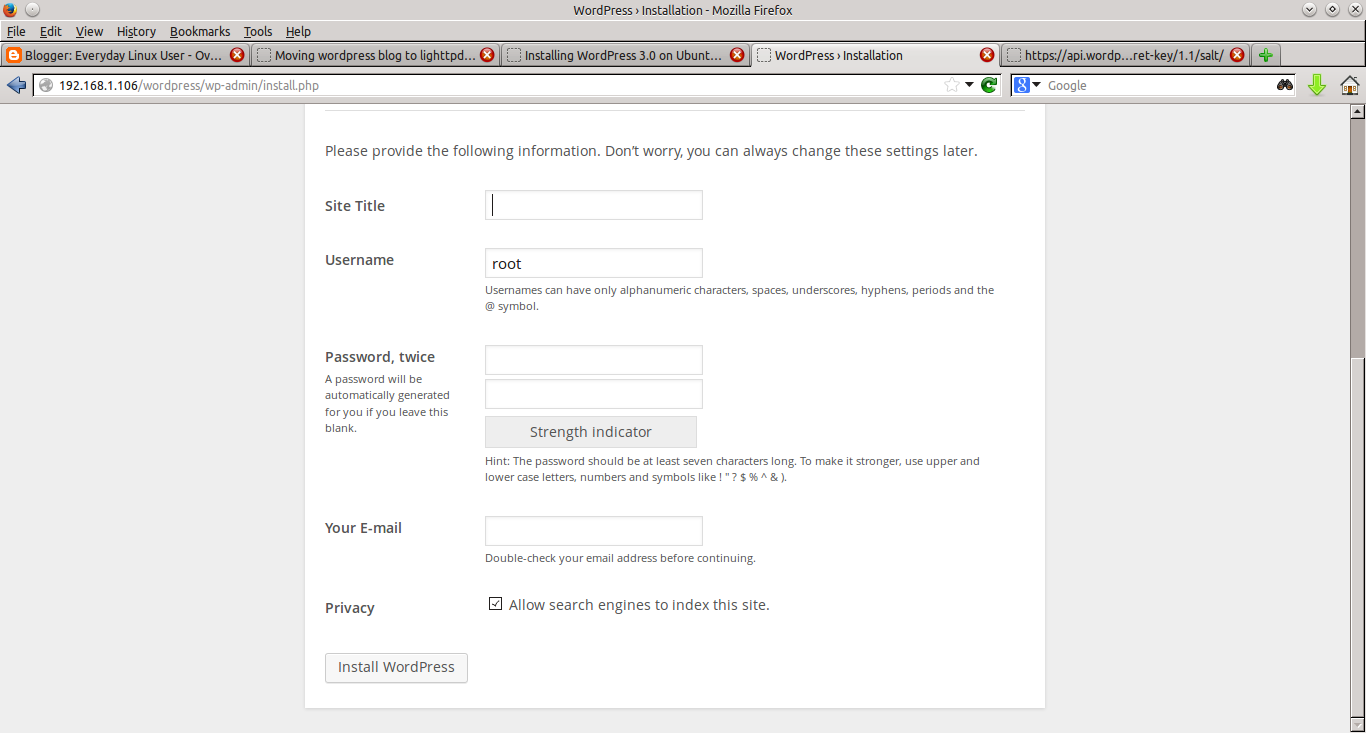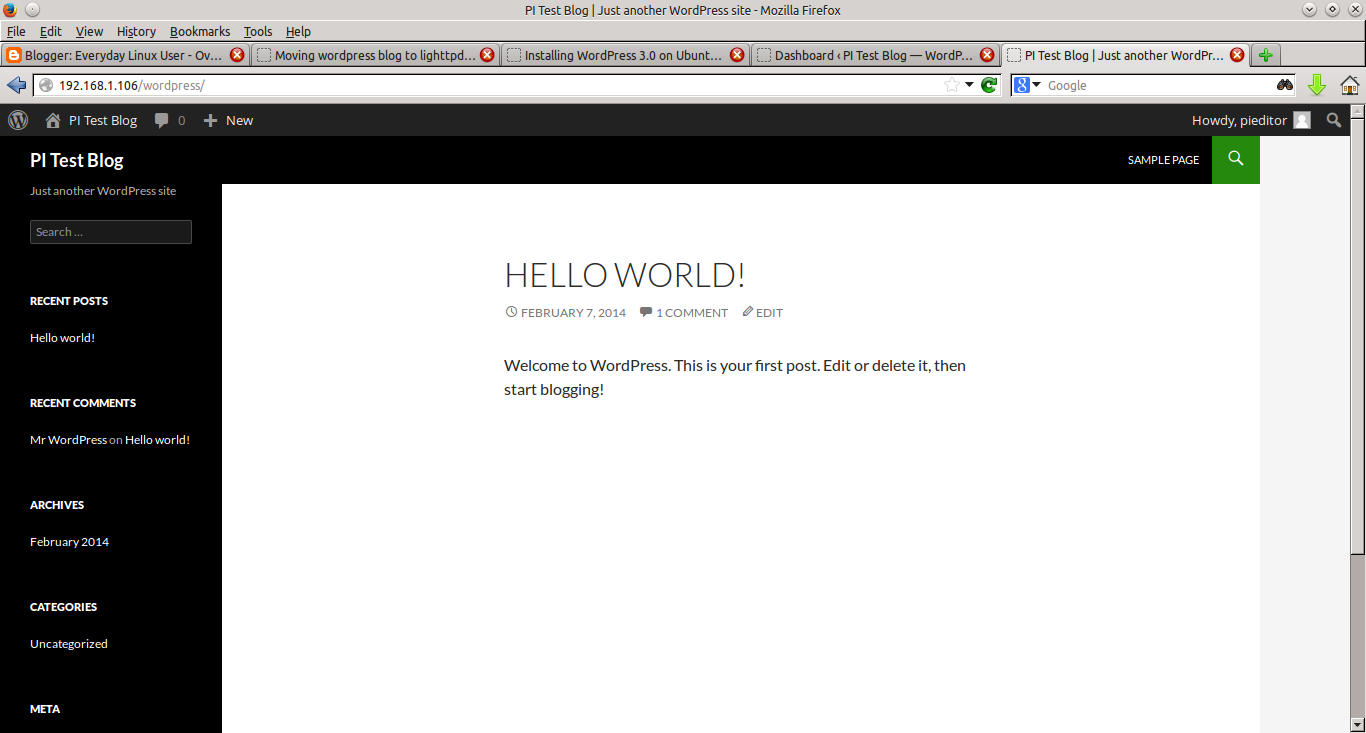Introduction
| I have already written articles showing how to set up the Raspberry PI and how to set up a personal web server on the Raspberry PI.
I was recently asked whether I could expand further and show how to install Wordpress onto the web server. To be able to follow this guide you will need to have set up your Raspberry PI and you will need to have PHP, MySQL, PHPMyAdmin and a web server such as Lighttpd or Apache installed. Follow the guide for setting up the personal web server linked above if you haven't already. |
Create the Wordpress database
The first part you can do from any other computer on the same network as the Raspberry PI. Make sure the Raspberry PI is turned on and that you can connect to it as a web server. (Follow the guide about setting up a personal web server if you are unsure how to do this).To create the Wordpress database open up a browser Window and navigate to PHPMyAdmin on the Raspberry PI. The address will be something like http://192.168.1.xxx/PHPMyAdmin. (Replace xxx with the last three digits that correspond to where your Raspberry PI is located).
Click on the databases tab at the top and where it says "create new database" add a new database with a name that relates to the purpose of your database. (For example "wordpress" or "piblog").
Set the collation sequence to the one that is most relevant for you. If in doubt choose utf8_general_ci.
Now you need to add a user that can interact with the database. Click on the "privileges" tab and click "add user".
For the username enter something like "piwordpress" and then enter your desired password into the password field and confirm that password in the re-type field.
Click "Create user" to add the user.
Click on "privileges" again and edit the user.
Now select "Check all" and save the changes. This gives your user permission to do anything on the database. (Not ideal for real world use by the way. For real world use you would restrict the access to the bare minimum required).
Connect to your Raspberry PI
First of all start up the Raspberry PI.If you are connected directly to the Raspberry PI and you have booted straight to the Raspbian desktop open up a terminal by clicking on the LXTerminal icon.
If you are connected directly to the Raspberry PI but it boots direct to the terminal you can move on to the next section.
If you are connecting via ssh then open up the application you use to ssh and connect using your username and the local IP address to the PI. My guide showing how to connect to the Raspberry PI from the Google Nexus will help with this and will also show how to VNC onto the Raspberry PI.
Download Wordpress
From within the terminal on the Raspberry PI run the following command to download Wordpress.
wget https://wordpress.org/latest.zip
Create the wordpress folders
Move the zip file to the /var/www folder by typing the following:sudo mv latest.zip /var/www/latest.zip
Navigate to the /var/www folder:
cd /var/www
Now unzip the latest.zip file:
sudo unzip latest.zip
This will create a folder called wordpress under /var/www and will contain all the sub folders and files for running Wordpress.
You can now remove the latest.zip file:
sudo rm latest.zip
To gain the appropriate permissions to the wordpress folder you need to change the permissions of the folder as follows:
sudo chown -R pi:users wordpress
Navigate to the wordpress folder by typing the following:cd wordpress
You now need to create a configuration file. The easiest way to do this is to take a copy of the sample Wordpress config file.
sudo cp wp-config-sample.php
wp-config.php
Open the file wp-config in the nano editor:
sudo nano wp-config.php

You need to change various parts of the config file as follows:
- DB_Name - change to the name of the database you created
- DB_User - change to the name of the user you created
- DB_Password - change to the password you created for the user
Visit https://api.wordpress.org/secret-key/1.1/salt/
A list of keys will be generated for you and you can copy and paste the keys into the file replacing the keys that are already there.
Press CTRL and O and then CTRL and X to save and exit the file.
Install Wordpress
Open a browser and navigate to http://192.168.1.xxx/wordpress/wp-admin/install.php. (replacing xxx with the appropriate value).
Enter a title for your site and then add a username and password for your site. (This can and should be different to your database username and password).
Finally enter and email address and click "Install WordPress".
After the installation is complete you will see the screen above. Enter your username and password to access the Wordpress control panel.
Summary
That is pretty much it. You can add templates and plug ins and do everything you normally would within Wordpress.If you want to see how your site looks simply open a new browser window and navigate to http://192.168.1.xxx/wordpress
Important:
This guide has been written as a proof of concept and because I was asked if I could write a guide for this.
I wouldn't recommend using this guide to set up your Raspberry PI as a production Wordpress server. Whilst the basics are correct, the setup of the database and the database user is lacking on the security front.
If you are a developer who creates Wordpress plugins and templates, you can now use your Raspberry PI to test out your creations.
I hope you find this guide useful and if you have any questions or the guide doesn't quite work for you let me know in the comments below and I will edit this article accordingly.
Thankyou for reading.










Don't take this the wrong way but this looks very much like a standard Wordpress on Debian install. I'm not seeing any tweaking or adjusting to accommodate the memory constraints of the Pi or maximising it's capabilities given the Pi's weak processor.
ReplyDeleteYou are right. This is a bog standard installation. The whole thing is a proof of concept as to whether it will work or not. I added a caviat to say that you shouldn't use these instructions for production use but they could be useful to a developer wanting to test out templates and add-ons
DeleteI tryed this some time ago, it works, but it is slow, wery slow. As far I can see, its the PHP that slows it down.
ReplyDeleteChange the graphical memory split to be less graphical thereby giving more resources to your server. Use lighttpd instead of Apache. You can also try the options for overclocking.
DeleteI found your blog quite interesting and the concern in the blog is really impressive. I always prefer to read the quality content and this thing I found in your post. Thanks for sharing.
ReplyDeletedj wallpapers
I cannot thank you enough. I've tried to install Wordpress under various tutorials and come across so many issues. This is the first one that actually worked. Thank you so much.
ReplyDeleteGlad to hear it. Thanks for letting me know
DeleteHey Gary
ReplyDeleteThis was a really fun post. The Raspberry Pi knows no limits :) Anyway, I thought this would be of value to our blog readers, so I included it in my roundup of the month's best Magento, WordPress, and ExpressionEngine content. http://blog.nexcess.net/2014/03/04/februarys-best-expressionengine-wordpress-magento-content/ Thanks for the nice work.
Ben
First available with WordPress Edition 2.8, this design tag profits the information of a tag. A tag ID can be approved as a parameter, but if no tag ID is approved, the information present queried tag will be came back.Because WordPress connections with this data source by itself, you as an end customer, shouldn't have to fear much about its framework.
ReplyDeleteThis is a great tutorial however I had hoped to see steps in setting up the FTP so that you can install/update plugins form the Wordpress control panel. any chances to adding a tutorial for that?
ReplyDeleteI got it to work with this command
Deletesudo chown -R www-data.www-data /var/www/MY_DIR
I was about to say yes I will write a tutorial for that but then it seems you have already achieved your aim.
DeleteCan you talk me through how I would set up the FTP settings so I could edit the site through Dreamweaver for example? Thanks
DeleteHi, I will see what I can do and will get back to you in the near future.
Deletehi, thanks for the tutorial,
ReplyDeletewhen i get to ; Open a browser and navigate to http://192.168.1.xxx/wordpress/wp-admin/install.php. i got a 404 - not found.
I can't find out what i did wrong, any idea?
This comment has been removed by the author.
DeleteI think its a good but incomplete start or beginners guide. PhpMyAdmin and Wordpress should be shown using a simple vhost instead of relying on default /var/www directory.
ReplyDeleteThanks for the guide though.
ReplyDeleteYou shared very informative post. i like this post. Thanks for sharing.
Magento Website Development Services